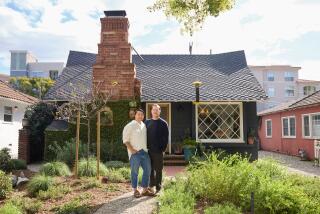Shaggy lawn fertile ground for controversy : Homeowner says she’s a natural environmentalist; neighbors call her yard an ecological disaster.
MINNETONKA, Minn. — Is Marjorie Kline a back-yard environmentalist or a lawn slob? It’s getting harder to make the call in an age where the traditional, manicured lawn is under attack as an ecological disaster.
Eschewing lawn mowers and commercial fertilizers, Kline has gradually gone natural, planting tree seedlings and wildflowers. Her shaggy front lawn contains liberal doses of clover and violets. Her mowers? Two pygmy goats named Lewis and Clark.
But where Kline sees a rich, small-scale wildlife habitat and goat pasture, some of her neighbors and the city see, well, weeds.
More than once, officials in this affluent Minneapolis suburb have threatened to invade her yard and mow it themselves.
So bitter has this battle become that Kline, a professional naturalist, has turned to the courts, seeking a restraining order preventing the city from cutting her lawn.
Never let it be said that people don’t feel passionately about their yards in Minnetonka. One of Kline’s fellow residents was on trial in October for allegedly murdering his neighbor over an unkempt yard.
Eleven of 19 households on Kline’s block have signed a petition complaining that her yard is unsightly and hurts their home values.
One neighbor spoke in court about surveillance conducted on Kline’s yard to observe weeds and learn how many hours of the day the goats were actually grazing. “There has been a proliferation of crab grass onto my property last year to this year,” testified Steven Shook, Kline’s next-door neighbor.
The judge, clearly frustrated over refereeing lawn politics, has encouraged mediation.
Similar dramas are playing themselves out all across the country as self-proclaimed environmentalists fight lawn ordinances that dictate how a yard should look. These rules usually require that weeds and grass be no more than 10 inches high. The National Wildlife Federation estimates at least 20 such cases are in the works around the country.
A group of homeowners is fighting a Chicago lawn ordinance, contending its use of the word “weed” is unconstitutionally vague, said Bret Rappaport, an attorney and Sierra Club member who is representing the homeowners for free.
The issue emerges as communities fighting drought and the effects of fertilizer and pesticide runoff are questioning the all-American lawn.
By some estimates, a gasoline-powered lawn mower creates as much air pollution in a half hour as a car driven for 172 miles. California and other states are beginning to regulate them as significant sources of pollution.
“Most communities have fairly old-fashioned lawn ordinances,” said Anne Hanchek, a University of Minnesota assistant professor and extension horticulturist. “They describe a ‘Cold War’ front lawn--the perfect expanse of green and not a weed in it.”
What’s starting to change is how they are being enforced, since many communities recognize the low-maintenance value of lawns containing more than Kentucky bluegrass. Others are scrapping and rewriting lawn laws, Hanchek said, adding that creating less formal urban landscapes requires planning and neighborhood cooperation.
Kline’s blue split-level house with white shutters looks like any other in the neighborhood. But her yard doesn’t. For one thing, the grazed grass isn’t all the same length. A large front-yard wildflower garden brims with the season’s remains of sunflowers, yarrow and columbine.
Kline is nothing if not enthusiastic as she walks through her half-acre lot, which adjoins a trail system, early one fall morning. She points out a prairie grass area she is creating near her property line, the garden where she grows strawberries, grapes and elderberries. There’s also a dead maple tree that is home to a pair of hairy woodpeckers. “Lots of people don’t realize the value of a dead tree,” she said.
Environmental considerations aside, Kline maintains that she is not in violation of the city lawn ordinance, because she is maintaining pasture land for her goats. And city law permits pasture.
But the city sees things differently: Rather than a carefully planned and executed natural landscape, Kline’s yard is a hodgepodge of tree seedlings, vegetable and flower gardens and unkempt grasses and weeds.
Also, the city feels unfairly depicted as an environmental villain in all this, because Minnetonka does allow many different landscapes, including prairie, pasture and wildflower gardens.
“Marjorie wants to simply let her grass grow,” said Desyl Peterson, a city attorney who said Kline is exploiting the pasture provision that allows for grazing of animals like cows, horses and goats. “A pasture is removed from the house . . . and doesn’t contain flowers, shrubs and a vegetable garden.”
Peterson sighed. “This file has become very thick.”
More to Read
Sign up for Essential California
The most important California stories and recommendations in your inbox every morning.
You may occasionally receive promotional content from the Los Angeles Times.










